-
With the introduction of IEEE 802.3an 10GBASE-T, it was determined that a new category of twisted-pair cabling was required to guarantee performance of the 10G network. Most of the time, Cat5e is suitable for 1G network. But now, many streaming media applications can be seen everywhere, the demands for faster data rates will be increased. These new applications are really pushing the limits of Cat5e cabling. Therefore, Cat6 will be a successful choice to deploy a new cabling system. So what is Cat6? What is the difference between Cat5e and Cat6? And so on. This article will provide simple answers to these questions.Q1: What Is Cat6?A: Cat6 is a standardized twisted pair cable for Ethernet and other network physical layers that is backward compatible with the Cat5/5e and Cat3 cable standards. Cat6 cables have a tighter twist in the cables allowing for two-way communication, which eliminate some or all cross talk with other cables. The cable standard provides performance of up to 250 MHz and is suitable for 10GBASE‐T / 100BASE‐TX and 1000BASE‐T / 1000BASE‐TX Gigabit Ethernet. In addition, the Cat6 cable is terminated in either the T568A scheme or the T568B scheme. So far, the T568B Scheme is the most widely used method of terminating patch cables.Q2: What Are the Differences Between Cat5e And Cat6?A: First, the cable construction. It is a observable difference. The diameter of Cat6 cables are in the range of 0.21 to 0.25 inch (5.3 - 5.8 mm), while Cat5e cables are in the range of 0.19 to 0.22 inch (4.8 - 5.5 mm). The reason is that Cat6 cables are manufactured with larger copper conductors and an internal divider that serves to separate the pairs within the cable and reduce cross-talk noise.Second, the speed. As I mentioned before, Cat6 cables are suitable for 10GBASE-T, or 10G Ethernet, while Cat5e cables support only up to 1000BASE-T, or 1G Ethernet. In addition, Cat5e and Cat6 have different distance under different transmission rate. Both Cat5e and Cat6 can allow 1G Ethernet up to 100 meters, but Cat6 has a lower max length (55 meters) and provides 33 meters in high cross talk conditions when used for 10GBASE-T (10 Gigabit Ethernet).Third, the frequency. Cat6 offers the available bandwidth up to 250 MHz, while Cat5e is up to 100 MHz. The performance improvements of Cat6 include better insertion loss, near end cross talk, return loss, and equal level far end cross talk, which allow higher reliability for current applications and higher data rates for future applications.Fourth, except the cable construction, speed and frequency, Cat6 has a tighter twist in the cables, which allows for two-way communication on each pair of wires, while Cat5e does not allow this feature.
 Q3: Will Cat6 Replace Cat5e?A: The answer is yes. Today, the choice for Cat6 tends to be an economic one. Although the installed cost for Cat6 cabling can be about 20 % higher than Cat5e, the benefits of Cat6 could overweight Cat5e in terms of bandwidth, transmission performance, reliability and application support. Besides, Cat6 is backward compatible to Cat5e, which makes it very easy for customers to choose Cat6 in their networks. So Cat6 will replace Cat5e in one day.Q4:What Should Notice about the Installation of Cat6?A: The installation of Cat6 is the same as Cat5e very much. However, there are some notes that should pay more attention to. The larger physical cable diameter needs to be taken into account when deploying the cable pathways. When terminating Cat6, it is very important to ensure that the pair twists are maintained right up to the point of termination. Equally, it is important to follow manufacturer's instructions for terminating connectors. A poor termination can significantly reduce performance or cause test failures in the field.Q5:What is the Shortest Link That the Cat6 Standard Allows?A: There is no short length limit. The Cat6 standard is intended to work for all lengths up to 100 meters. According to the ANSI/TIA/EIA-568-B.1, the consolidation point should be located at least 15 meters away from the telecommunications room, in order to reduce the effect of connectors in close proximity.Q6: Is Cat6 Used in the Residential Market?A: Yes, Cat6 will be very effective in the residential market to support higher Internet access speeds. The better balance of Cat6 will make it easier to meet the residential EMC requirements compared to Cat5e cabling. What's more, the growth of streaming media applications to the home will increase the need for higher data rates which are supported more easily and efficiently by Cat6 cabling.SummaryWhat we can make conclusion is that Cat6 is the smartest choice for 1G/10G copper cabling system implementations. In the long term, the performance improvements offered by Cat6 will produce an extended operational life span and protection of your Cat6 infrastructure investment.
Q3: Will Cat6 Replace Cat5e?A: The answer is yes. Today, the choice for Cat6 tends to be an economic one. Although the installed cost for Cat6 cabling can be about 20 % higher than Cat5e, the benefits of Cat6 could overweight Cat5e in terms of bandwidth, transmission performance, reliability and application support. Besides, Cat6 is backward compatible to Cat5e, which makes it very easy for customers to choose Cat6 in their networks. So Cat6 will replace Cat5e in one day.Q4:What Should Notice about the Installation of Cat6?A: The installation of Cat6 is the same as Cat5e very much. However, there are some notes that should pay more attention to. The larger physical cable diameter needs to be taken into account when deploying the cable pathways. When terminating Cat6, it is very important to ensure that the pair twists are maintained right up to the point of termination. Equally, it is important to follow manufacturer's instructions for terminating connectors. A poor termination can significantly reduce performance or cause test failures in the field.Q5:What is the Shortest Link That the Cat6 Standard Allows?A: There is no short length limit. The Cat6 standard is intended to work for all lengths up to 100 meters. According to the ANSI/TIA/EIA-568-B.1, the consolidation point should be located at least 15 meters away from the telecommunications room, in order to reduce the effect of connectors in close proximity.Q6: Is Cat6 Used in the Residential Market?A: Yes, Cat6 will be very effective in the residential market to support higher Internet access speeds. The better balance of Cat6 will make it easier to meet the residential EMC requirements compared to Cat5e cabling. What's more, the growth of streaming media applications to the home will increase the need for higher data rates which are supported more easily and efficiently by Cat6 cabling.SummaryWhat we can make conclusion is that Cat6 is the smartest choice for 1G/10G copper cabling system implementations. In the long term, the performance improvements offered by Cat6 will produce an extended operational life span and protection of your Cat6 infrastructure investment. your comment
your comment
-
Modern business have become increasingly digital for cloud and data center application, which means everything from sales and marketing to service and support, rely heavily on a fast and reliable network. In 2017, Gigabit Ethernet data rate is no longer adequate to support your business in the ever-developing digital world. Therefore, more and more people nowadays prefers to migrate to 10 Gigabit network. This blog will introduce some basic components of 10G network and how to layout 10GbE within your budget.
How Much Does It Cost?
Three expensive but dispensable elements of 10G network are 10G core switches, access switches with 10G uplinks, and 10G network interface cards for severs and storage devices.

A 10G core switch might cost you $4000 10 years ago, but today, it heavily drops to under $150 per port. Take Cisco 550X and 350X series switches as the example, they offer a full series of 12, 16, 24, 48 10G ports for small and midsize enterprises nearly at $1,500. Obviously, the price can be pretty lower if you search around. For example, Ubiquiti Unifi and Edgeswitch series switches nearly at $200 are suitable for small businesses. FS S3800-48T4S with 48x 100/1000Base-T and 4x 10GE SFP+ is at $480.
For 10G access switches with 10G uplinks, FS S3800-24F4S, S3800-24T4S, S2800-24T4F provides 24 ports with 4 10G uplinks, starting from around $220.
A 10G network interface card (NIC) on severs or storage devices cost usually lower depending on the brand. The hot-selling Mellanox ConnectX series NICs are quite cheap on ebay and Amazon (for under $19).
10G Fiber Optic cabling Elements—10Gbase-T, DAC & SFP+ fiber optics?
When migrating from 1G to 10G, it is simple. Especially with 10GBase-T supported on your 10G switches, you use the same familiar RJ45 network cable to connect the 10G switch with your servers, storage and other switches, and they go up to the same 100 meters as in the Gigabit network. Just make sure you pick up a Cat6a RJ45 network cable instead of the cat5e or cat6a cables. 1m cat6a cables at FS.COM is $3.4. 10GBase-T technology is becoming more popular in network switches and servers because of its lower cost and ease of use. Besides the cat6a/cat7 Ethernet cables, you can also select SFP+ 10GBASE-T modules with 2.5W power consumption and a maximum distance of 30m. SFP+ 10GBASE-T offered at FS.COM is nearly $380.
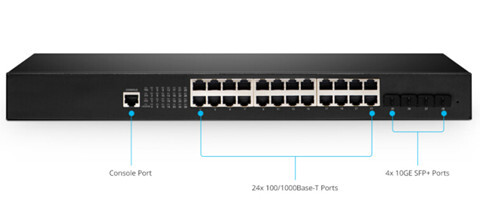
FS S3800-24F4S (seen in the above image), S3800-24T4S and S2800-24T4F also support 10G SFP+. You are recommended to use SFP+ ports if you have existing devices that come with 10G SFP+ port or you need a 10G connection to other switches that are more than 100 meters away.
For servers or storage devices with 10G SFP+ port, the most cost-efficient way to connect is to use SFP 10G DAC (direct attach cable). These are basically copper cables with SFP+ connector on both sides, and they come in limited length of 1m, 3m and 5m. 0.5m 10G DAC cables at FS.COM is $9.5.
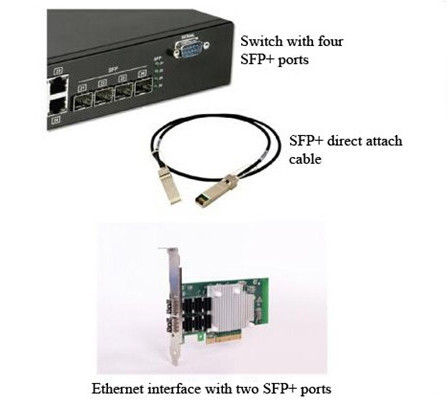
For switches that are more than 100 meters away, you will need a pair of SFP+ modules and the matching fiber cable between them. Depending on the length required, you can use multimode SFP+ and fiber to reach 400 meters and single-mode SFP+ and single-mode fiber optic cables to reach 10 km.
How to Ensure a Smooth 10G Upgrading
You don’t need to rush your whole network to 10GbE in one step. Just start from the core switches that you use to connect all your access switches together and connect your servers and storage devices. Think about how many ports you need and if redundancy is a concern for you. Having two core switches stacked together to provide redundancy and also extra performance is a good design for a solid network foundation.
After upgrading your core switches to 10G, it is time to migrate your key access switches and servers to 10G. You will see immediate performance gain in the most critical parts of your network. The rest of the network can stay as they are for the moment, because 10GBase-T ports are backward compatible with Gigabit links, and 10G SFP+ cage can also work with 1G SFP modules. You can upgrade the rest of your network to 10G whenever you’re ready or in multiple phases if you wish.
Conclusion
I bet you must have a good understanding of what’s between the 10 Gigabit high-performance network. The technology is not complicated, especially with FS 10G switches, Cat6a cables, SFP+ transceivers and SFP+ DAC cables. We will help you build a user-friendly and cost-efficient 10G networks.
 your comment
your comment
-
25G Ethernet was treated as the “new” 10GbE technology once it came out in 2014. Similar to 10G Ethernet that was based on 1 x 10Gbps lane scheme, 25GbE physical interface delivers 1 x 25Gbps more data. 25GbE technology with one single lane obviously improves the port density and cost requirement. 25GbE network supports several 25Gbps capable form factors, such as CFP, CFP2, CFP4, SFP28 (1×25 Gbps) and QSFP28 transceiver (4×25 Gbps), which is also used for 100GbE. Of which 25G SFP28 SFP-25G-SR and SFP-25G-LR are two popular optical transceiver modules on the market, the former supporting up to 100m link length while the latter allows a maximum transmission distance of 10 km. This article will make a brief comparison between 25G SFP-25G-SR & SFP-25G-LR optical transceiver modules, and analyze the utilization in 25G to 100G upgrading.
SFP-25G-SR Overview
SFP-25G-SR is 850nm VCSEL 25Gigabit SFP28 transceiver designed to transmit and receive optical data over 50μm duplex LC multimode optical fiber (MMF). 25G SFP28 SR optics can support up to 70m over parallel OM3 Multimode fiber and 100m over parallel OM4 cable. This 25G SFP transceiver is equipped with Digital Optical Monitoring (DOM) function and can be delivered with different temperature ranges, allowing access to real-time operating parameters.

SFP28 SR MMF transceiver optics is comply with current specifications of IEEE 802.3, SFF-8472, SFF-8402, SFF-8432 and SFF-8431. It’s suitable for use with 25GbE Ethernet switches, routers, network interface cards (NICs) and storage networking equipment. The SFP28 SR optics offers the most power efficient way to meet the growing needs of the next-generation data center networking environment.
SFP-25G-LR Outline
SFP28-25G-LR is the SFP28 LR optical transceiver module for 25 Gigabit Ethernet long-reach application. This SFP28 LR optics module features a highly reliable 1310nm DFB transmitter and PIN photo-detector into duplex LC optical connector, providing links up to 10km over single mode fiber (SMF).

The SFP28 LR SMF transceiver optics is comply with current specifications of IEEE 802.3, SFF-8472, SFF-8402, SFF-8432 and SFF-8431. It’s suitable for use with 25GbE Ethernet switches, routers, network interface cards (NICs) and storage networking equipment. The SFP28 LR optics offers the most power efficient way to meet the growing needs of the next-generation data center networking environment. The above image displays the vivid comparison between 25G SFP28 LR optics and 40G QSFP+ LR4 modules.
SFP-25G-SR & SFP-25G-LR Used in 25G to 100G Data Center Migration
Energy saving and cost are the two important considerations for data center applications. Nowadays 10G Ethernet speed can not meet the demands of increased sever performance, and the 100G relevant devices are too expensive, the appearance of 25G Ethernet standards just made up for the deficiency of them. Compared with 40GbE connectivity, 25GbE requires just one lane (four with 40GbE) but offers superior switch port density, lower costs and power requirements. Therefore, 25GE is good choice as next step after 10GE for SMF and MMF transceivers.
SFP-25G-SR and SFP-25G-LR are the single-channel, pluggable, fiber-optic SFP28 modules for 25 Gigabit Ethernet and Infiniband EDR applications, with low power dissipation 1W.
- 100G to 25G MMF Short-reach Connection
As the following image shows, MTP12 to 4xLC MMF fiber breakout cables are needed to connect between 100G QSFP-100G-SR4 and 25G SFP-25G-SR. This connection types can support up to 100m.

- 100G to 25G SMF Long-reach Connection
As the table 2 shows, SFP28 SFP-25G-LR connects with QSFP28 QSFP-100G-PSM4 over the MTP12 to 4xLC SMF fiber breakout cable. The whole setup can support up to 500m over parallel single mode fiber.

Conclusion
With the rapid development of Internet, cloud computing and big data in recent years, the construction of IT infrastructure data center has been accelerated. A new round of updating is underway for the Ethernet including 25GbE, 40GbE, 50GbE, of them 25G Ethernet is favored. 25G SFP-25G-SR and SFP-25G-LR SFP28 optical transceivers provide smooth and cost-effective solution to 100G networks.
 your comment
your comment
-
Technology is changing rapidly. Just when you got used to Gigabit Ethernet speeds being a fast & reliable system, someone unveiled 10GbE, 25GbE, 40GbE or even 100GbE systems a few years later. The newer and higher performing iterations are indeed the great breakthrough for telecommunication industry, but also pose difficulty in choosing network migration path—10G to 40G to 100G, or to 25G to 50G to 100G. We have described 10G, 25G, 40G and 100G Ethernet technology before, now in this blog, we’d like to introduce the four fiber optic cabling, and compare two 100G migration paths.
Cost-effective 10GbE Fiber Optic Cabling10 Gigabit Ethernet technology defined by IEEE 802.3ae-2002 standard, is matured nowadays. Just like the “old” Gigabit Ethernet, 10Gb network can be terminated with either copper or fiber cabling. 1000BASE-T standard usually uses the Cat5e cables as the transmission media, while 10GbE bandwidth requires high grade copper cables like Cat6/Cat6a/Cat7 cables to support 10Gbps data rate. For instance, 10G SFP+ 10GBASE-T transceiver modules utilize Ethernet copper cables (Cat6a/Cat7) for a link length of 30m. SFP+ direct attach cables (DAC) and active optical cables (AOC) are also regarded as the cost-effective solutions for 10G short-reach applications. Besides 10G copper cables, there are single-mode (OS2) and multimode fiber patch cables (OM3/OM4) applied to different 10GbE IEEE standards. For the detailed information about the 10G cabling options, please see the following table.
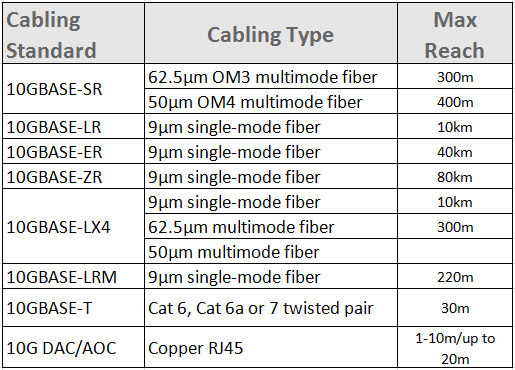
As to the 10G fiber optic transceivers, there are a series of optical form factors including the XENPAK, X2, XFP, SFP+. The former three 10GbE optical transceivers were released earlier than smaller 10G form factor—SFP+ module. However, owing to their larger footprint, they are not successful on the 10G hardware market. Furthermore, SFP+ optics, compliant with several IEEE standards (SR, LR, LRM, ER, ZR and 10GBASE-T...) wins the heart of 10G end-users.
Singe-lane Design Makes 25GbE ShineWhen 25G Ethernet was developed to support a single-lane 25Gbps standard in 2014, it was treated as the “new” 10GbE technology but delivers 2.5 times more data. Compared to 40GbE that was based on 10GbE, 25GbE with one lane obviously improves the port density and cost requirement. 25GbE network can support both copper and fiber optic cables, seen in the below table.Similar to 10GbE networks, 25G Ethernet physical interface specification supports several 25Gbps capable form factors, including CFP/CFP2/CFP4, SFP28 (1x25 Gbps) and QSFP28 (4x25 Gbps), which is also used for 100GbE. SFP28 25GBASE-SR and 25GBASE-LR SFP28 are two popular 25GbE optical transceiver modules available on the market, the former supports up to 100m link length while the latter allows a maximum transmission distance of 10 km.
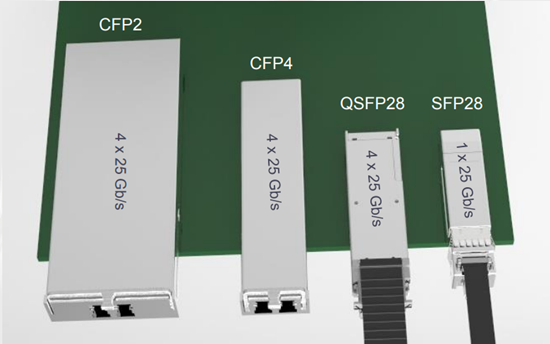
The available optical switches of the market do not support direct 25GbE connections using an SFP28 direct attach copper (DAC) cable. It is recommended to use a breakout cable that allows four 25GbE ports to connect to a 100GbE QFSFP28 switch port. FS.COM SFP28 DAC cable lengths are limited to four meters (1m, 2m, 3m, 5m) for 25GbE. And if you prefer a longer length, the 25GbE active optic cable (AOC) solutions are good recommendations.
25G Optics SFP28 Type Media/Reach All 25G SFP28 Ports 25GBASE-SR 50µm MMF / 70m 25GBASE-LR 9µm SMF / 10km 25GBASE-AOC Pre-terminated in 3, 5, 7, 10, 15, 20, 25, 30m lengths OM4 MMF MTP/MPO 150m 25G Copper SFP28 Type Media/Reach All 25G SFP28 Ports 25GBASE-CR Twinax / 'Direct Attach' Pre-terminated in 1m, 2m, 3m, 5m lengths Fast & Reliable 40GbE Fiber Optic CablingLike the 10GbE fiber optic cabling, there are several IEEE standards of 40GbE transceiver in the whole evolution. 40G QSFP+ optical transceivers are the most commonly used optics for 40G network. So how to choose fiber optic cables for 40G optical transceivers? The following table will help you out.
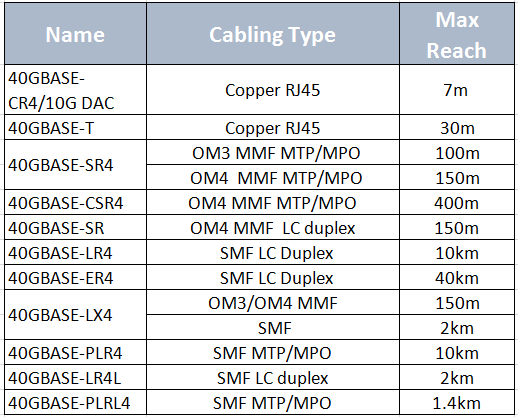
Besides the QSFP+ fiber transceivers and fiber optic cables, 40G DAC cables available in QSFP+ DAC cables and AOC cables enable short-reach options. For 40G cabling, QSFP+ to QSFP+ (40G to 40G) and QSFP+ to 4SFP+ (40G to 10G) breakout cables satisfy customers for various fiber types and reach requirements.
100GbE Fiber Optic Cabling For Future ProofingWith the price of 100G optics cutting down in 2017, 100GbE network is no longer out of customers’ reach. Telecom giants like Cisco, Arista, HPE launches series of 100G optical switches to meet the market demand. And for other 100G components like 100G optical transceivers, fiber patch cables, racks & enclosures, etc, those are ubiquitous on the market.
100G optical transceivers including the CFP, CFP2, CFP4, CXP and the most popular 100G QSFP28 optics in IEEE standards provide a great selection to the overall users.For 100G inter-rack connections, QSFP28 to QSF28 Direct Attach Copper (DAC) Cables and Active Optical Cables (AOC) as well as the QSFP28 to SFP28 breakout cables are the cost-effective solutions.
ConclusionThis article introduces 10G/40G/100G fiber optic cabling, and make a clear comparison between the two paths to 100GbE. Customers prefer 4×25Gbps for the reasons: Less parallel paths, less fibers, less optics, less everything. For those who want to upgrade from 40G to 100G, appreciate the reliable performance of 40G with the potential to run across 2 parallel 25Ghz rather than 4 required today.
 your comment
your comment
-
With the price of 100G optics cutting down, 2017 witnesses the great expansion of `100G hardware market. QSFP28 and CFP 100G optical transceivers are becoming popular among customers. Not only Cisco, HPE, Brocade, and Huawei, but the third party vendors like FS.COM offer 100G devices including the 100G switches, MTP/MPO cables, QSFP28, CFP/CFP2/CFP4 and so on. In this blog, I will compare 100G QSFP28 SR4 with CFP SR10 modules, and analyze the electrical and optical diagram.
CFP 100GBASE-SR10 Module Outlook
CFP 100GBASE-SR10 is a MSA specified 100G C-form factor supporting link lengths of 100 m/150 m over laser-optimized OM3/OM4 cable, respectively. It is mainly used in 10 x 10 Gigabit Ethernet mode along with MTP Harness cables for connectivity to 10 10GBASE-SR optical interfaces. It usually enables high-bandwidth 100Gbps links over 24-fiber MPO/MTP ribbon cables.
100G QSFP28 100GBASE-SR4 Outlook
QSFP28 100GBASE-SR4 module is a parallel 100G optics designed with optical/electrical connection and digital diagnostic interface. It offers 4 independent transmit and receive channels, each capable of 25Gbps operation for an aggregated data rate of 100Gbps for 100m on 12-fiber MPO/MTP OM4 fiber cable. Figure 1 shows the CFP SR10 (left) and QSFP28 modules (right).

The QSFP28 SR4 transceiver (such as Cisco 100G-QSFP28-SR4) is compatible with 100G QSFP 100GBASE-SR4 standards that meets IEEE 802.3 and MSA requirements with power dissipation well under 3.5W. It supports both 100GBASE-SR4 as well as 4x25G breakout, 100G QSFP28 to QSFP28 DAC and 100G QSFP28 SR4 to 4SFP28 break-out cables.
Comparison Between CFP 100GBASE-SR10 and 100G QSFP28 100GBASE-SR4
- Size Comparison
CFP module is the old generation 100G transceivers. It is designed after SFP modules, but quite larger to support 100Gbps in 10 x 10Gbps lanes. QSFP28 is the newly released 100G form factor, which further increase port density and reduce footprint & power consumption. QSFP28 100GBASE-SR4 has the same form factor as the 40G QSFP optics, supporting 4x25Gbps mode.

The above image shows the size comparison between CFP 100GBASE-SR10 and 100GBASE SR4 QSFP transceiver. Obviously, QSFP28 is much smaller than CFP 100G modules, which just in time explains the reason that QSFP28 optics is more popular than CFP transceivers.
- Working Principle
As noted before, QSFP28 SR4 modules work on 4x25G lanes and CFP SR10 operates over 10x10G lanes.


100GBASE-SR4 supports higher speed per channel (25Gbps) than 100GBASE-SR10 (10Gbps), so that QSFP28 can reduce port density with compact footprint.
- Terminating Cables—12F Vs. 24F MTP/MPO MMF
Both CFP 100GBASE-SR10 and 100G QSFP28 100GBASE-SR4 terminates with MTP/MPO OM3/OM4 cables for 100G transmission. However, QSFP28 100GBASE-SR4 modules uses a 12 fibers MPO/MTP multimode cable for connectivity (4 Tx and 4 Rx, each lane providing 25 Gbps of throughput) while CFP 100GBASE-SR10 optics use a 2×12-fiber or 24-fiber strand MPO/MTP multimode cable for connectivity (10 Tx and 10 Rx, each lane providing 10 Gbps of throughput).
CFP 100GBASE-SR10, compared with QSFP28 SR4 optics uses two 12-fiber or one 24-fiber MPO/MTP cable. It is not a cost-effective solution in terms of the cable management.
Conclusion
100GBASE-SR10 CFP and 100GBASE-SR4 QSFP28 are the 100G multimode optics. QSFP28 SR4 transceivers, like 40GBASE-SR4, use a 12 fiber MPO cable with 4 strands for transmit and 4 for receive. While CFP 100GBase-SR10 optics uses a 24 strand MPO cable: 10 strands for transmit and 10 strands for receive. From the above article, we know that 100GBase-SR4 QSFP28 is more cost-effective than 100GBase-SR10 CFP in port density and cable management.
 your comment
your comment




